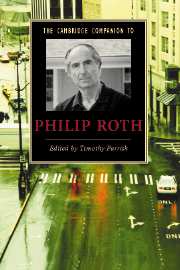Book contents
- Frontmatter
- Introduction: Roth at mid-career
- 1 American-Jewish identity in Roth’s short fiction
- 2 Roth, literary influence, and postmodernism
- 3 Zuckerman Bound: the celebrant of silence
- 4 Roth and the Holocaust
- 5 Roth and Israel
- 6 Roth’s doubles
- 7 Revisiting Roth’s psychoanalysts
- 8 Roth and gender
- 9 Roth and ethnic identity
- 10 Roth’s American Trilogy
- 11 Roth’s autobiographical writings
- Further reading
- Index
9 - Roth and ethnic identity
Published online by Cambridge University Press: 28 May 2007
- Frontmatter
- Introduction: Roth at mid-career
- 1 American-Jewish identity in Roth’s short fiction
- 2 Roth, literary influence, and postmodernism
- 3 Zuckerman Bound: the celebrant of silence
- 4 Roth and the Holocaust
- 5 Roth and Israel
- 6 Roth’s doubles
- 7 Revisiting Roth’s psychoanalysts
- 8 Roth and gender
- 9 Roth and ethnic identity
- 10 Roth’s American Trilogy
- 11 Roth’s autobiographical writings
- Further reading
- Index
Summary
An American who happens to be a Jew
Addressing an audience in Israel, Philip Roth once defined himself as an American writer who happens to write about Jews. With this simple statement Roth perfectly captures the complicated blending of cultural identities that marks his work. The irony one may perceive from noticing that one of Roth's most quoted statements about his cultural identity as a writer occurs before an Israeli audience should not prevent one from recognizing that it is impossible to talk about Roth's Americanness without also addressing his Jewishness. Perhaps more powerfully than any other writer, Roth exemplifies a cultural pattern endemic to post-World War II American writing: the more ethnic his work seems, the more American it becomes. Thus, Roth has always insisted that he is primarily an American writer, yet his work cannot be fully understood without addressing how Roth engages a sense of Jewish history that cannot be understood to be equivalent with his perspective as an American writer. From this perspective, Roth's work has been part of a large turning point by which contemporary American writers have been reinventing diverse literary and cultural heritages through fictive reconstructions of ethnic pasts. Many contemporary African-American, Native-American, Hispanic-American, and Asian-American writers look to, or invent, pre-American pasts in order to define their present American identities. Roth's work has as its premise the knowledge that his historical situation as an American is known to him through the eyes of being a Jew and the descendant of Jews.
- Type
- Chapter
- Information
- The Cambridge Companion to Philip Roth , pp. 127 - 141Publisher: Cambridge University PressPrint publication year: 2007
- 2
- Cited by



